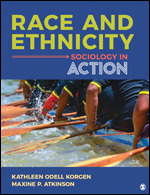You are in: Caribbean
Change location
You are here
Reflecting on Colorblind Language and Racism
Activity: Looking at Race and Ethnicity—and Power
- Time frame: Approximately 30 Minutes
- Setting: Online or face-to-face
- Source: Chapter 1 (Learning Outcome 1.4)
from Race and Ethnicity: Sociology in Action,
edited by: Kathleen Odell Korgen and Maxine P. Atkinson - Contributor(s): Sarah Becker, Ifeyinwa Davis, Crystal Paul
Doing Sociology 1.4 Reflecting on Colorblind Language and Racism
In this exercise, you will analyze colorblind language. Colorblind racism often manifests itself in specific language styles that generally allow White people to “talk nasty about minorities without sounding racist” (Bonilla-Silva 2010). Have you ever heard a person say or do any of the following?
-
“I’m not prejudiced, but . . .” (followed by a prejudiced statement)
-
“Some of my best friends are . . .” (after making a prejudiced statement about people in the group the person’s “best friends” belong to)
-
“I’m not [Black/Latinx], so I don’t know” (followed by a prejudiced statement)
-
“Yes, but couldn’t that just be due to (social class, poverty, or any other factor that isn’t race)?”
-
Stutter, take awkward lengthy pauses, repeat themselves, say um or ah a lot, or simply be incoherent when talking about race
Reflect on one of the times you have heard (or heard of) someone saying or doing one of these things. Briefly write down the story and then answer the following questions:
-
Who was part of the interaction?
-
Why do you think the person said what they did?
-
How might these language choices affect the possibility of honest conversation about race?
Note to Instructors:
This exercise can be done in two stages. First, students can volunteer to share their experiences. This can be done anonymously in an online forum or face-to-face in discussion, depending on the level of trust and rapport students have with one another and with you. Conversation about the potential effects of colorblind rhetorical moves can occur in small groups online or in person—and students can draw on stories their peers shared. After working in small groups, each group can report themes of their discussion to the larger class and it can serve as a basis for introducing additional research on colorblind racism and/or as a way to transition into talking about structural, cultural, and interpersonal manifestations of racism.

